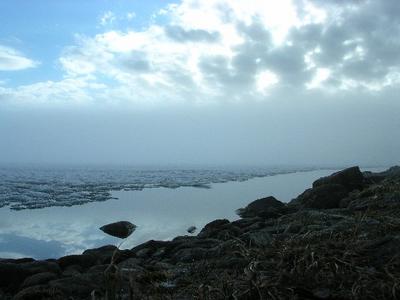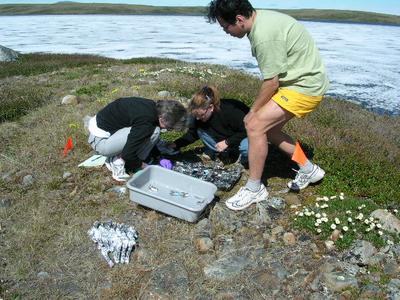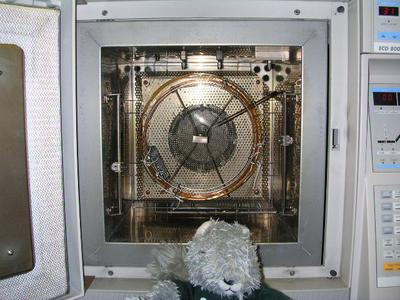12 June, 2004
The days are starting to blend into each other;
the 24 hours of light blurs the line between one day and next.
Sleeping at night still feels like a nap. Yesterday the first wisps
of cirrus clouds appeared in the sky; this morning, shadows of
cumulus clouds danced across the tundra. The ice on the lake has
been melting quickly; with the morning's breeze from the north, the
ice started to push into the shoreline, the rhythmic creaking of the
seasons on a well-worn floor.
This morning, we started the photobleaching experiment:
photo - light; bleaching - bleaching (duh). In this
experiment, Penney is measuring how light affects water from
different lakes (with different amounts of dissolved organic carbon).
"Ohhhh," you say (don't even try to deny it: I hear you now) and
think "Who cares?"
It goes like this: dissolved organic carbon absorbs harmful
ultraviolet light, preventing it from harming the bacteria, algae and
other organisms that make their home at the surface of the water.
Dissolved organic carbon acts at a sponge from organic pollutants.
Then, when the carbon does break down, the pollution the carbon has
sucked up gets broken down too. At least that's our hypothesis.
Penney is investigating how light changes the properties of dissolved
organic carbon and its ability to absorb (and eventually help
degrade?) organic pollutants.
You may be wondering why some lakes have more dissolved organic
carbon than others. The answer is still a mystery and worth a PhD.
Interesting fact to make you smarter:
Ultraviolet light has a tricky time traveling through glass or
plastic, but travels quite easily through water (and quartz - thus,
the quartz tubes to hold the samples). If you're fair-skinned,
playing in the water will not protect you from sunburns.
Equipment Notes:
Gas chromatograph
The gas chromatograph is basically a very fancy oven with a long
glass tube sticking through it. The glass tube is rolled into a coil
in order to get a longer tube into a pretty small space.
To better understand how a gas chromatograph works, it is useful to
understand chromatography in general: chromato = light;
graphy = mapping.
Doing the following activity is a simple way to see liquid
chromatography in action.
a. Cut a paper towel into strips about 10 cm (5 inches) long.
b. Use a toothpick or pencil to poke a small hole at one end
of strip. Thread the toothpick or pencil through the holes.
c. At the other end of the strip about 3 cm from the bottom,
draw a horizontal line with a water-based marker (or with a Q-tip
dipped in food coloring)
d. Fill a tall glass or cup with enough water so that the
paper towel just barely touches the top of the water.
e. Hang the strip over the glass so that ONLY the tip of the
strip touches the water. Take care to prevent the strip from
touching the walls of the glass and the colored line from touching
the water.
f. Wait for 15 - 30 minutes.
After some time, you will see the colors used to make up the marker
or food coloring start to separate, pulled apart by the water rising
through the paper towel.
g. If you want even more fun, try new colors, Kool-Aid
crystals and Skittles.
h. If you are feeling sophisticated, use permanent markers
and rubbing alcohol.
Lighter liquids are pulled up the chromatogram more easily than
heavier liquids and so travel farther in the same amount of time.
In a gas chromatograph, a liquid is injected into the oven and heated
up. Some parts of the liquid turn to gas (volatilize) faster than
others so escape up the long glass tube faster than others. By
measuring the type and amount of gas leaving the oven over a
parcticular amount of time, we can infer what the liquid was made up
of.
Interesting fact to make you smarter:
DNA samples are tested using the same principle, but use electricity
to separate parts rather than gravity (liquid chromatography) or
volatilization (gas chromatography).
Amanda's Limerick
To the Arctic a group of us went
Some were brave enough to sleep in their tents
The nights they were mild
And the scenery wild
Too bad our autosampler got bent.
--

1. Toolik Lake on a misty morning

2. Preparing for photobleaching experiment

3. Laying out samples for photobleaching experiment

4. Inside of gas chromatograph
Contact the TEA in the field at
.
If you cannot connect through your browser, copy the
TEA's e-mail address in the "To:" line of
your favorite e-mail package.
|
